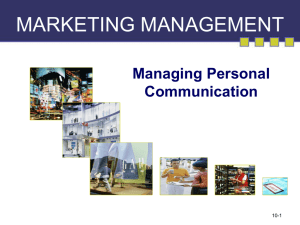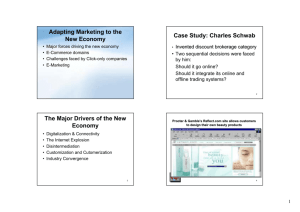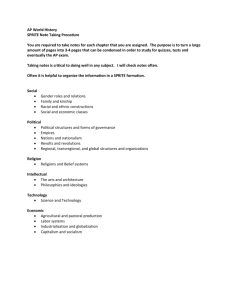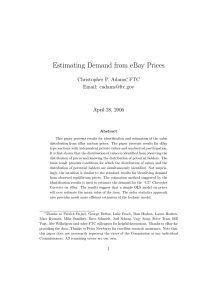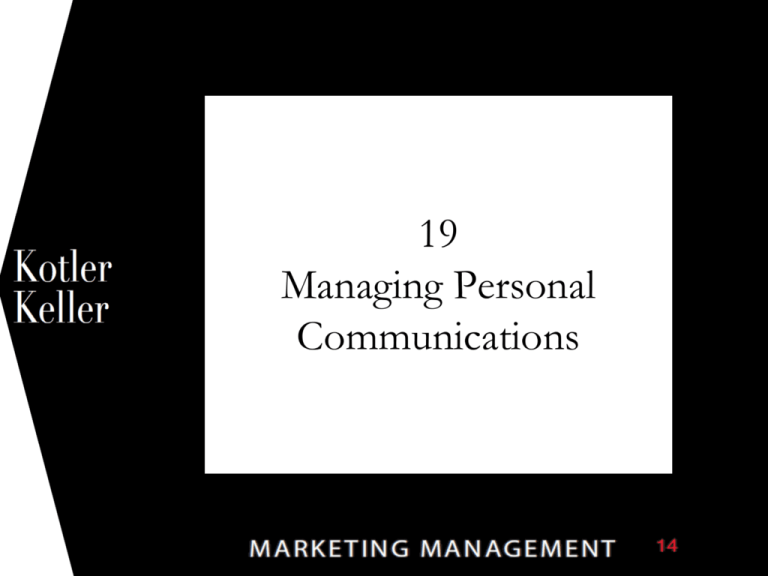
1
19
Managing Personal
Communications
Chapter Questions
How can companies use integrated direct
marketing for competitive advantage?
How can companies do effective e-marketing?
What decisions do companies face in designing a
sales force?
How do companies manage a sales force
efficiently?
How can salespeople improve selling,
negotiating, and relationship marketing skills?
19-2
Direct Marketing
Use of consumer-direct
channels to reach
and deliver goods and
services to
customers without using
market middlemen.
19-3
The Rebirth of Direct Marketing
Interactive dialogue & direct
interface between producers and
customers
The Relationship Paradigm
(Relationship Marketing or
Customer Relationship
Management)
19-4
Accommodating the Relationship Paradigm
Marketing is an organizational
function and a set of processes
for creating, communicating,
and delivering value to
customers and for managing
customer relationships in ways
that benefit the organization
and its shareholders (AMA –
September 2004)
19-5
The development of Information Technology has eased the
growth of direct marketing (and the relationship marketing)
19-6
The Future of the Internet
Revolutionary for
certain industries
and incremental for
others.
Conversational Marketing
“Markets are
conversations”
E.g., MySpace (used by Warner Bros)
Facebook (Coca-cola has a Sprite page & “Sprite Sips” game).
19-8
Creating horizontal communication
19-9
Direct Marketing Channels
Catalogs
Direct mail
Telemarketing
Web sites
Email marketing
Mobile devices
Interactive TV
19-10
Buy a book and it is auto-delivered wirelessly
in less than one minute.
19-11
Public Issues in Direct Marketing
Irritation
Unfairness
Deception/fraud
Invasion of privacy
19-12
Constructing A Direct-Mail Campaign
Establish objectives
Select target prospects
Develop offer elements
Test elements
Execute
Measure success
19-13
RFM Formula for Selecting Prospects
Recency
Frequency
Monetary value
19-14
Elements of the Offer Strategy
Product
Offer
Medium
Distribution method
Creative strategy
19-15
Components of the Mailing
Outside envelope
Sales letter
Circular
Reply form
Reply envelope
19-16
Types of Telemarketing
Telesales
Telecoverage
Teleprospecting
Customer service and
technical support
19-17
Other Media for Direct Response
Television
• Direct Response
Advertising
• At home shopping
channels
• Videotext
Kiosks
19-18
Designing an Attractive Web Site
Context
Content
Community
Customization
Communication
Connection
Commerce
19-19
Ease of Use and Attractiveness
Ease of Use
Downloads
quickly
First page is easy to
understand
Easy to navigate
Attractiveness
Clean
looking
Not overly crammed
with content
Readable fonts
Good use of color and
sound
19-20
Increasing Visits and Site Stickiness
Deep information
with links
Changing news of
interest
Changing offers
Contests and
sweepstakes
Humor and jokes
Games
19-21
Online Ads
Banner ads
Microsites
Sponsorships
Interstitials
Search-related ads
Content-targeted
advertising
Alliances
Affiliate programs
19-22
e-Marketing Guidelines
Give the customer a reason to respond
Personalize the content of your emails
Offer something the customer could not
get via direct mail
Make it easy for customers to unsubscribe
19-23
IMC Perspective
The eBay ad shows
how firms use
traditional mass media
advertising to drive
website traffic.
15-24
These materials have been reproduced with the permission of eBay Inc.
COPYRIGHT ©EBAY INC. ALL RIGHTS RESERVED.
Figure 19.2 Designing a Sales Force
Sales force objectives
Sales force strategy
Sales force structure
Sales force size
Compensation
19-25
Types of Sales
Representatives
• Deliverer
• Order taker
• Missionary
• Technician
• Demand creator
• Solution vendor
19-26
Sales Tasks
Prospecting
Targeting
Communicating
Selling
Servicing
Information gathering
Allocating
19-27
Figure 19.3 Managing the Sales Force
Recruiting, selecting
Training
Supervising
Motivating
Evaluating
19-28
Workload Approach to Determining
Sales Force Size
Customers are grouped into size classes
Desirable call frequencies are established
Number of accounts in each size class multiplied
by call frequency
Average number of calls possible per year
established
Number of reps equal to total annual calls
required divided by number possible
19-29
Components of Sales Force
Compensation
Fixed amount
Variable amount
Expense allowances
Benefits
19-30
What Motivates Sales Reps?
Most Rewarding
Pay
Promotion
Personal growth
Sense of
accomplishment
Least Rewarding
Liking
Respect
Security
Recognition
19-31
Principles of Personal Selling
Be an active
order getter
Identifying
customers’ latent
needs and come
up with sound
product solution
19-32
Figure 19.4 Steps in Effective Selling
Prospecting/ Qualifying
Preapproach
Approach
Presentation
Overcoming objections
Closing
Follow-up
19-33
Relationship Marketing Perspective
• Personal
Selling &
Negotiation : not
necessarily always
transaction-oriented
•That is, not just
immediate sales, but
to build long-term
supplier-customer
relationship.
19-34



